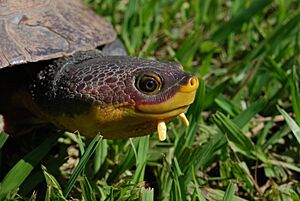Hoge's side-necked turtle facts for kids
Quick facts for kids Hoge's side-necked turtle |
|
|---|---|
 |
|
| Conservation status | |
| Scientific classification | |
| Genus: |
Ranacephala
|
| Species: |
hogei
|
| Synonyms | |
|
|
The Hoge's sideneck turtle (Ranacephala hogei) is a special type of turtle. It belongs to the family called Chelidae. This turtle is the only one in its group, known as Ranacephala.
You can only find this turtle in the eastern Atlantic Forest of Brazil. It mainly lives in the Carangola River in Minas Gerais and the Paraíba do Sul River in Rio de Janeiro. The largest known group lives in the Carangola River. There are likely fewer than 2,000 of these turtles left.
The Hoge's sideneck turtle is considered the most endangered turtle in Brazil. In 2018, the Turtle Survival Coalition listed it as one of the world's "25 Turtles in Trouble." This means it is very important to protect them.
Contents
Why Is It Called Hoge's Sideneck Turtle?
The turtle's specific name, hogei, honors a scientist. It was named after herpetologist Alphonse Richard Hoge. He was a Belgian scientist born in Brazil who studied reptiles and amphibians.
What Threats Does This Turtle Face?
The Hoge's sideneck turtle faces many dangers. These threats make it hard for them to survive.
Habitat Loss and Pollution
One big problem is that their home is being destroyed. People are cutting down forests, which is called deforestation. This takes away the places where turtles live and nest. Also, dirty water from sewage and factories pollutes the rivers. Farm chemicals also run into the water. All these things make the water unsafe for the turtles. Building dams on rivers also changes their habitat.
Dangers from Fishing
Fishing can also harm these turtles. They can get caught on fishing hooks. To help, people are now using special hooks that are safer for turtles. Also, two areas along the Carangola River have been made "no-fishing zones." This helps protect the turtles there.
Low Genetic Diversity
Scientists have studied the turtles' genes. They found that these turtles have very little genetic diversity. This means their genes are very similar to each other. This might be because their population became very small a long time ago. Low genetic diversity makes them weaker. They might get sick more easily. It also makes it harder for them to adapt to changes in their environment.
How Are We Protecting Hoge's Sideneck Turtle?
Many people and groups are working to save the Hoge's sideneck turtle.
Protecting Nesting Areas
In 2015, a large piece of land was bought to protect the turtles. This land was 236 acres along the Carangola River. It was bought by Rainforest Trust and Fundação Biodiversitas. This area is very important for turtles to lay their eggs. It is now a special protected area. Hoge's sideneck turtles need thick forest to nest. So, clearing forests near the river is very bad for them.
The Rainforest Trust also thanked other groups for their help. These include the Turtle Survival Alliance (TSA) and the Wildlife Conservation Society. They all worked together to create the Hoge's Side-necked Turtle Reserve.
Teaching People About Turtles
In 2014, a special program was started. It teaches people about the Hoge's sideneck turtle. This program includes an educational video. It also has materials for teachers to use in classrooms. Teaching people about these turtles helps everyone understand why they need protection.


